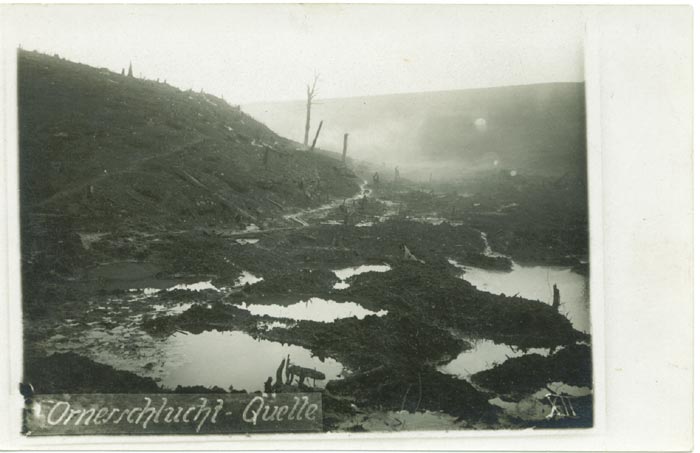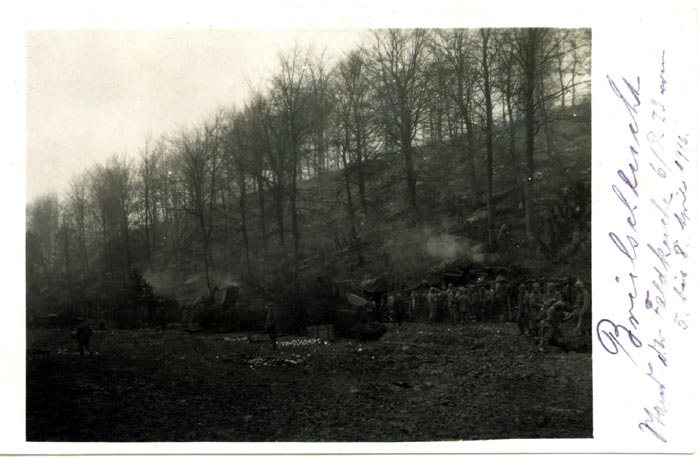-
Posts
949 -
Joined
-
Last visited
Content Type
Profiles
Forums
Blogs
Gallery
Events
Store
Posts posted by David Gregory
-
-
Despite the fact that I didn't take any pictures (I left that to Chris and Tony), the trip was a resounding success.
We covered quite a bit of ground and certainly deserved the liquid and other refreshment every evening.
To make up for the fact that I didn't take any pictures of my own, here are some older ones of a few places places we visited.
The Ornes ravine was the scene of bitter fighting, but this image shows the source of the River Orne during a quiet period. Apart from the fact that the forest has completely covered the landscape again, it really hasn't changed since this picture was taken:
[attachmentid=54199]
We also walked along the Brule ravine, which was a major supply route to the front lines throughout the late spring and summer of 1916. It, too, has now been fully reclaimed by nature, which made it impossible to find the exact spot where the field kitchen of 6. Kompagnie, Reserve-Infanterie-Regiment Nr. 73 was located from 5th to 8th April 1916:
[attachmentid=54204]





 0
0 -
Well, Chris and I have arrived safe and sound.
The weather is slightly warmer and wetter than the beer, but we will prevail.
Tony, if you read this in time, you ought to bring a rain coat just in case. Some beer would go down well, too.
See you at Vaux tomorrow,
David
0 -
Where the regiment was the rest of the time: http://www.militaerpass.net/18id.htm
0 -
Andrew,
I apologise for the late reply. I have an overview of the division online at http://www.militaerpass.net/1brd.htm
David
0 -
Mark,
In the generally accepted sense, a Beamter is a public or civil servant.
For the purposes of militaria collectors, it would equate to just about anyone who is essentially a civilian, but attached to or working direct for the military and therefore wearing uniform.
David
0 -
Great thread and good examples of the common men who often only had a simple EK2 for their sacrifices.
I really must find some time to scan some documents and post them.
0 -
Jason,
I think you are right in assuming it was a private purchase item or a privately "enhanced" bronze medal. I have one mounted in first place next to an EK2 on a two-place bar.
Three-place EK2 + "other state's approximate equivalent" + Hindenburg cross bars are good examples of typical awards to the men that survived the war.
Unfortunately, I am not particularly disciplined and have examples of both two place bars (EK2 + "other state's approximate equivalent") and three-place bars as described above for most of the entities of the German empire from 1914-18. I mainly collect award and service documents and only acquire medal bars if they come with the paperwork or as representative examples to match the documents I have.
David
0 -
Excellent analysis of a single document!
I wonder if there is any connection between Oberk?chenmeister Graf von P?ckler and F?rst P?ckler ice cream?
0 -
This is all I can show you at very short notice. Look closely at the edges of the green and brown areas to see the difference in the patterns. The edges of the areas in the one you show seem to be less ragged and much "tidier", which is not what I would expect to see.
This is an original Zeltbahn in the same pattern as the smock is supposed to be:

If you can find exactly the same elements of this pattern on the smock, it might be good. If these exact elements poisitoned in the same way cannot be found and the material of the smock feels like well washed, smooth cotton, then it is certainly an aged reproduction. The buttons on the smock as seen below are definitely not German:
 0
0 -
Andr?,
You should compare the weave of the material and the printed pattern with a known original.
I have handled many original Zeltbahn shelter quarters and a few original smocks, which are made of the same material. From the pictures you show in the link, this is not an item in which I would invest more than EUR 200. The material seems to match some of the cheaper reproductions in my opinion.
David
0 -
Thanks Rick

David, let's plan for a little vacation...pack the rucksacks with the Norwegian beer Ringnes and go for a hike

Cheers, Stefan
Stefan,
That is something I would seriously consider. I won't be able to manage it in June of this year due to other commitments, but it is something worth looking into for later.
David
0 -
And apparently he couldn't make up his mind how to align the L?beck ribbon!
Well done for reuniting the two bars.
By coincidence I am just looking through some photos that came with a group of documents including a Milit?rpass, Soldbuch and award documents for the L?becker Hanseatenkreuz, EK2, Hindenburg cross and Kyffh?user medal to a man who served with IR 162 and IR 426. The photos suggest that your later bar has the L?beck cross ribbon correctly fitted.
0 -
My self landing on a Russian Parachute...
Chris,
Are you the guy in control of his canopy or the less fortunate individual doing an impersonation of a snow plough?
Being dragged across frozen ground near a fence (barbed wire?) is part of the steep learning curve that encourages careful selection of the next DZ.
Do the canopies have openings for a bit of forward movement or are they very basic circular designs?
David
0 -
Fascinating report, which has survived remarkably well.
It would be interesting to trace the route they took using similar equipment (minus perhaps the MPs) to find out what can be seen from that period and how long it would take today.
0 -
Hi Guys,
IM can still be seen used as an abbreviation for In Memoriam on ordinary German gravestones.
Don't be surprised if it takes the Volksbund a long time to reply, if at all.
David
0 -
Douglas,
Thanks for a nice presentation of a piece many collectors will never be able to own. Do you shoot it?
David
0 -
Attachments to and cross-training with airborne units of friendly nations and allies is not at all unusual.
Your vet may have done the US jump course and qualified. Alternatively, he may have spent time or briefly served with a US airborne unit that unofficially "awarded" him their jump wings if he was considered to have satisified the award criteria.
Whether his parent unit actually allowed foreign jump wings to be worn more than 50 years ago is another matter. It is not unusual to see qualification badges of other nations worn by NATO soldiers today.
0 -
Swords are not my "thing", but that is an astonishing example of craftsmanship no longer found in this day and age.
 0
0 -
Perhaps the "0" number key got stuck while he was posting the auction
 0
0 -
Lucky find - I wish my local flea market was as good as yours!
I seem to remember the square used as a mark on 1914 iron crosses. Is it a mark used by the same maker on both 1939 and 1914 crosses?
0 -
Excellent document and a very nice connection to the officer he served with!
The Bavarian Ministerpr?sident at the time the document was issued was Ludwig Siebert, which I would never be able to fathom from his signature.
0 -
Preussag AG, established in 1923 as Preu?ische Bergwerks- und H?tten-Aktiengesellschaft, started out in the mining and steel industry and, following a number of merges and changes in ownership, became the largest tourist group in the world when it acquired Thompson Travel Group in 2000. Preussag AG now goes by the name of TUI AG.
Does SBM refer to a medal connected with the mining sector?
0 -
Heiko,
As far as I am aware, the figure of just over 400 refers to the total number of 1st class crosses awarded.
Someone with a copy of the Ohm-Hieronymussen book will be able to tell you for sure how many of each type were actually awarded.
David
0 -
Heiko,
If I recall correctly, just over 400 crosses were awarded in total.
You might want to take a look at the thread at http://gmic.co.uk/index.php?showtopic=4663&st=0 where you can see two of mine, among others.
David
0




Dead man
in Battlefields, Bunkers & Concrete
Posted
Like the other German units at Verdun, Reserve-Infanterie-Regiment Nr. 73 did not spend all its time there in the front line. When it was rotated out of the line, the regiment was based in Romagne.
In an attempt to make some then-and-now comparisons, we visited the village and tried to find the street corner where this image shows men of 6. Kompagnie returning for a period of rest in May 1916. Unfortunately, we didn't know that the French destroyed the village by long-range artillery fire towards the end of the war.
[attachmentid=54206]
After trying to find the same spot, we had to ask a local where he thought the picture might have been taken. In fact, the photo was taken about 30 yards from his front door. The tree on the left of the picture above was in the centre of an ornamental fountain, the wall of which can just be seen on the left between the soldiers in the original photo. The row of houses no longer exists, the sign being where the buildings ended to the right behind the soldiers marching down the street.
A smaller version of the destroyed fountain was rebuilt at some time after the war. 90 years and 4 months later, Chris took approximately the same photo of Tony and I standing next to the fountain, which in the photo above is obscured by the soldiers returning for a spell away from the fighting.